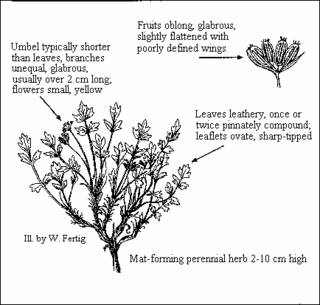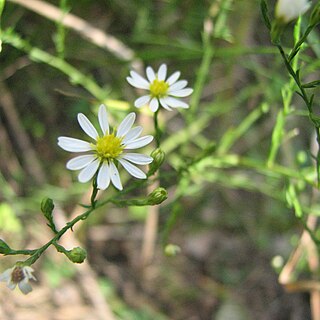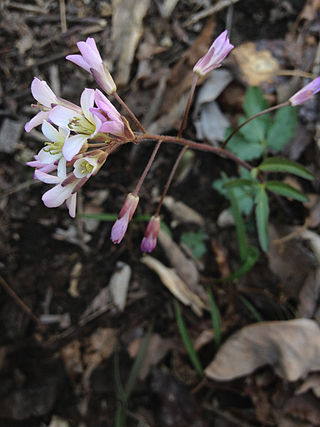
Ptilimnium is a group of plants in the family Apiaceae described as a genus in 1819. The common name is mock bishopweed or mock bishop's weed. It is endemic to the United States, primarily in the Southeast, the Lower Mississippi Valley, and the Lower Great Plains.

Tiarella cordifolia, the heart-leaved foamflower, is a species of flowering plant in the family Saxifragaceae. The specific name cordifolia means "with heart-shaped leaves", a characteristic shared by all taxa of Tiarella in eastern North America. It is also referred to as Allegheny foamflower, false miterwort, and coolwort.

Tiarella, the foamflowers, is a genus of flowering plants in the family Saxifragaceae. The generic name Tiarella means "little turban", which suggests the shape of the seed capsules. Worldwide there are seven species, one each in eastern Asia and western North America, plus five species in eastern North America. As of October 2022, the taxonomy of Tiarella in eastern North America is in flux.

Cardamine concatenata, the cutleaved toothwort, crow's toes, pepper root or purple-flowered toothwort, is a flowering plant in the family Brassicaceae. It is a perennial woodland wildflower native to eastern North America.

Vaccinium crassifolium, the creeping blueberry, is a species of Vaccinium in the heath family. It is native to the four southeastern U.S. states of Virginia, North Carolina, South Carolina, and Georgia. It is an evergreen shrub with shiny dark green to bronze leaves. Cytology is 2n = 24.

Aletes has been regarded a genus of flowering plants in the family Apiaceae, all of which are endemic to North America. As of December 2022, Plants of the World Online regarded Aletes as a synonym of Cymopterus, while GRIN Taxonomy regarded it as a possible synonym of that genus.

Sibbaldia tridentata is a species in the plant family Rosaceae. Its synonyms include the illegitimate name Sibbaldia retusa and Sibbaldiopsis tridentata. Under the latter name, it has been treated as the only species in the genus Sibbaldiopsis. Its English names include three-toothed cinquefoil, shrubby fivefingers, and wineleaf.

Cymopterus is a genus of perennial plants in the family Apiaceae native to western North America. They are commonly known as the spring parsleys and are edible. They are mostly stemless, taprooted perennial herbs with leaves at ground level and flowering scapes bearing yellow, white, or purple flowers.

Sisyrinchium montanum, the blue-eyed-grass, American blue-eyed-grass, or strict blue-eyed grass, is a grass-like species of plant from the genus Sisyrinchium, native to northern North America from Newfoundland west to easternmost Alaska, and south to Pennsylvania in the east, and to New Mexico in the Rocky Mountains. It has also been introduced to parts of France, likely during the First World War.

Phlox nivalis is a species of flowering plant in the Polemoniaceae family with the common name of trailing phlox. It is native to the southeastern United States, Texas, Michigan, and Utah. One subspecies of this plant, Phlox nivalis subsp. texensis, the Texas trailing phlox or Texan phlox, is a rare plant federally listed as an endangered species of the United States. The subspecies is endemic to Texas, where there are populations in three counties. At one time, the subspecies was thought to be extinct. It was rediscovered in 1972.

Rainiera is a monotypic genus of flowering plants in the daisy family, Asteraceae. The single species, Rainiera stricta(Greene) Greene, is endemic to the northwestern United States. The genus is part of the tribe Senecioneae, and appears to be most closely related to Luina, another genus of northwestern North America, in which it was once placed. Rainiera stricta is of conservation concern, with a G2G3 ranking from NatureServe, and is considered to be globally imperiled. It is known by the common name false silverback.

Symphyotrichum depauperatum, commonly known as serpentine aster or starved aster, is a rare species in the family Asteraceae adapted to serpentine barrens, an ecosystem with a high concentration of toxic metals in the soil. It has been found in Pennsylvania, Maryland, and on some diabase glades in North Carolina. It grows to 50 centimeters and has white ray florets surrounding a center of yellow disk florets.

Tradescantia ozarkana, the Ozark spiderwort, is a species of Tradescantia. It is part of the Commelinaceae family, native to the States of Missouri, Arkansas, and Oklahoma in the south-central United States. It flowers from April to May and can be found in rich, rocky areas, including woods and bluff ledges.

Cardamine angustata is a perennial forb native to the eastern United States, that produces white to pink or purple flowers in early spring.

Tradescantia longipes, commonly known as the wild crocus, is a perennial herbaceous plant in the dayflower family. It is found only in the Ozark Mountains of southern Missouri and northern Arkansas in the Midwest United States. A spring blooming species, its flowers can be observed from April to May, typically in its preferred habitat of wooded slopes on rocky hillsides. While most other members of the genus in North America have stems reaching at least a few inches above the soil, the flowering shoots of Tradescantia longipes are borne essentially at ground level. This character is shared with some individuals of Tradescantia hirsuticaulis and Tradescantia virginiana, two closely related species, although both typically have obvious stems. Regardless, Tradescantia longipes can be distinguished from the former with its longer pedicels and bracts without fine hairs, and from the latter by the presence of at least some glandular hairs on the sepals. Furthermore, Tradescantia longipes is a tetraploid, meaning it has four sets of chromosomes, while Tradescantia hirsuticaulis is diploid with only two sets. Tradescantia virginiana occurs in both diploid and tetraploid forms, although it is consistently tetraploid where its range overlaps with Trandescantia longipes.

Arisaema stewardsonii is a species of flowering plant in the arum family Araceae. It is a member of the Arisaema triphyllum complex, a group of closely related taxa in eastern North America. The specific name stewardsonii honors American botanist Stewardson Brown (1867–1921). It is commonly known as the bog Jack-in-the-pulpit. It is sometimes referred to as the swamp Jack-in-the-pulpit, not to be confused with Arisaema pusillum, which is also known by that name.
Harperia is a group of plants in the Restionaceae described as a genus in 1904. The entire genus is endemic to the State of Western Australia.

Symphyotrichum turbinellum, with the common names of prairie aster, smooth violet prairie aster, and mauve-flowered starwort, is a species of perennial flowering plant in the family Asteraceae native to the United States in Arkansas, Illinois, Iowa, Kansas, Louisiana, Missouri, Nebraska, and Oklahoma, primarily in the Ozarks. It has gained the Royal Horticultural Society's Award of Garden Merit. It flowers from August to October.

Ptilimnium capillaceum, known by the common name of herbwilliam, is a member of the carrot family, Apiaceae. It is a perennial herb, native to the eastern United States, from Texas to Massachusetts.




















